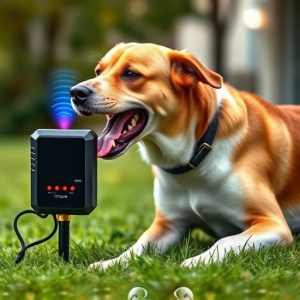Electronic Dog Deterrents: Science-Backed Protection Against Aggression
Understanding and addressing dog aggression requires identifying root causes like fear, anxiety, or…….
Understanding and addressing dog aggression requires identifying root causes like fear, anxiety, or past trauma. Modern electronic dog deterrents, leveraging technology like ultrasonic devices and motion-activated systems, offer humane alternatives to traditional methods. These repellents use inaudible signals or scent cues to discourage aggressive behavior without harm. Effective deployment involves strategic placement, reliable power sources, and signage. Regularly checking battery life is crucial for optimal performance, ensuring continuous protection against unwanted canine visitors using Dog Repellent Low Battery Warning Signs.
“Unleash a safer, more controlled environment with our comprehensive guide to aggressive dog deterrent electronic solutions. Understand the science behind these innovative tools, learn to identify and address root causes of dog aggression, and explore traditional vs. modern repellent methods. Discover key components for implementing an effective system while navigating best practices. Plus, gain crucial insights into low battery warning signs and maintenance for continuous protection. Empower yourself with this essential resource.”
- Understanding Dog Behavior and Aggression: Identifying the Root Cause
- Traditional vs Modern Dog Repellent Solutions: An Overview
- The Science Behind Electronic Dog Deterrents: How They Work
- Implementing an Effective Dog Repellent System: Key Components and Best Practices
- Low Battery Warning Signs and Maintenance: Ensuring Continuous Protection for Your Space
Understanding Dog Behavior and Aggression: Identifying the Root Cause
Understanding dog behavior is crucial when addressing aggression. Dogs, like humans, have unique personalities and triggers that can set off defensive or aggressive responses. It’s essential to identify why a dog is displaying such behavior. Common causes include fear, anxiety, territorial instincts, or past traumatic experiences. For instance, a dog with a history of abuse may react aggressively when sensing potential threats in its environment.
Owner actions play a significant role too. Inattention, lack of proper training, or inconsistent handling can contribute to aggressive tendencies. If a dog’s boundaries are not well-defined, it might resort to aggression to protect itself or its territory. Identifying these root causes is key to finding the right solution, such as electronic deterrents designed to address specific behavioral issues without causing harm. Keep an eye out for low battery warning signs in these devices to ensure their effectiveness and longevity.
Traditional vs Modern Dog Repellent Solutions: An Overview
In the realm of dog deterrents, the shift from traditional to modern electronic solutions is a significant development. Traditional methods often relied on visual cues, scent markings, or even physical barriers, which could be invasive and inconsistent. These methods may have had limited success in specific scenarios, but they lacked adaptability and intelligence. Modern dog repellent solutions, however, leverage technology to offer more refined, efficient, and humane alternatives. Ultrasonic devices, motion-activated systems, and remote-controlled repellents are some of the innovative tools that utilize sound, movement, or scent to deter dogs without causing them harm. These modern solutions not only address immediate problems but also learn from behavior patterns over time, adapting their response accordingly.
While traditional dog repellents may have been reliable in certain environments, they often required constant monitoring and could be triggered by non-target animals or environmental factors. Modern electronics, on the other hand, come with features like low battery warnings, automatic shut-off mechanisms, and customizable settings. These innovations ensure that the devices remain effective without requiring continuous human intervention. Moreover, modern solutions are designed to be more environmentally friendly and humane, using safe sound frequencies or scent signals that dogs find unpleasant but humans generally cannot detect. This evolution in dog repellent technology not only enhances effectiveness but also aligns with ethical considerations regarding animal welfare.
The Science Behind Electronic Dog Deterrents: How They Work
Electronic dog deterrents have revolutionized the way we address aggressive canine behavior. The technology behind these devices is based on principles of sound and vibration, which are perceived differently by dogs compared to humans. When a dog approaches within a certain range, these systems emit high-frequency sounds or vibrations that are typically inaudible to human ears but can startle and deter the animal. This sudden alert signals to the dog that it’s approaching too close, encouraging it to back off.
Unlike traditional methods that rely on spraying chemicals or physical barriers, electronic deterrents offer a safe, humane alternative. They’re especially effective for training purposes, teaching dogs their boundaries without causing them harm. Moreover, these devices often come with low battery warning signs, ensuring optimal performance when needed most. Regular maintenance of battery levels is key to ensuring the system remains effective in deterring unwanted canine behavior.
Implementing an Effective Dog Repellent System: Key Components and Best Practices
Implementing an effective dog repellent system involves a combination of cutting-edge technology and strategic placement. The core components include motion sensors, sound emitters, and, in some cases, spray dispensers. These devices work together to detect and deter dogs through a multi-layered approach—sensing their presence, emitting unpleasant sounds or sprays, and providing clear, visible warnings.
Best practices suggest installing the system along perimeters, focusing on areas where dogs frequently enter. Regular maintenance is key; ensure devices are powered by reliable sources and that batteries are replaced promptly to avoid false triggers caused by low battery levels. Clear signage can also help train dogs and owners alike, indicating the presence and operation of the repellent system. Dog Repellent Low Battery Warning Signs are crucial reminders for pet owners to keep systems operational, ensuring ongoing effectiveness in keeping unwanted canine visitors at bay.
Low Battery Warning Signs and Maintenance: Ensuring Continuous Protection for Your Space
Regularly checking your dog repellent’s battery life is crucial for maintaining its effectiveness as a deterrent. Low battery warning signs are an essential aspect to keep in mind, as they indicate when it’s time to replace or recharge the device. Most modern models feature LED indicators that signal power levels, allowing you to stay proactive. By addressing battery maintenance promptly, you ensure continuous protection for your space, whether it’s a backyard, parking lot, or any area requiring dog deterrence.
To prevent unexpected malfunctions, establish a maintenance routine. This includes periodic inspections to confirm proper functionality and calibrate the device as needed. Keeping an eye on these low battery warnings is a simple yet vital step in ensuring the reliability of your electronic dog repellent system.
In light of the above discussions, an aggressive dog deterrent electronic solution offers a modern, effective approach to managing canine aggression. By understanding dog behavior and implementing key components for an efficient system, you can create a safe space. Regularly checking for low battery warning signs is crucial for continuous protection, ensuring your home or property remains secure from unwanted visitors. This innovative technology provides a humane alternative to traditional deterrents, offering peace of mind in today’s digital era.


